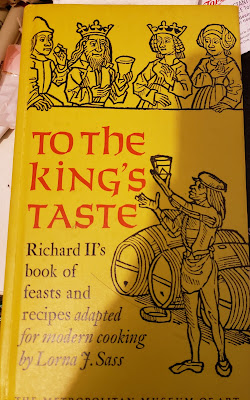Book Review: To The King's Taste.
I was recently gifted with a copy of Lorna J Sass' "To the King's Taste: Richard II's Book of Feasts and Recipes Adapted for Modern Cooking". Published in 1975 and is now out of print. I do see that there is a used copy on Amazon for $14, though. It is a small book, which is both a pro and a con. Pro, because recipes are one to two pages each. Con because there isn't enough page space to provide explanations for any changes made to the source material. Sass does provide, for each recipe, the original recipe, her translation of the recipe into modern English, and her redaction including modern oven temperatures and times. In the introduction, she explains that she spent years testing the recipes and explains that she does make changes to produce a better taste for the modern pallet. "In my interpretations I have departed from the original instructions at times. For example, when I boiled the rabbit for "Connynges in Cyrip", I found the meat to be tough and tasteless. So I recommend browning it in seasoned flour. ... My aim has been to find a common meeting ground for the medieval palate and our own..." [p34]
The recipes are well organized and are written in an accessible fashion, only basic cooking skills are needed for most of the recipes. And there is a detailed glossary. Most of the recipes come from "The Forme of Cury"; the few that don't, she provides the source information.
Sass is known, today, for her many books on vegetarian and vegan cooking, but she does have a PhD in medieval literature so she was well equipped to translate the 14th Century English of Richard II. As a two time winner of the James Beard Award for her writing (1982 and 2007) she does have the cooking skills to back up her redactions. In 1977 she wrote "To the Queen's Taste: Elizabethan Feasts and Recipes", also out of print.
That being said, I wish more page space was used to explain why all of her changes were made. On pages 90 and 91, she gives two recipes for sauces: galantine and cameline. In both of her redactions she suggests stock be added even though stock is not mentioned in the source material. No reasoning is listed for galantine sauce, but for the cameline sauce she says, "If you don't temper the sauce with broth, it is quite pungent, although this quality is set off considerably by the spices and sweet raisins." Is the same true for the galantine sauce? It would be nice to know.
She also provides different spices for recipes requiring pouder fort, pouder douce or whyte pouder. It would have been better, in my opinion, to have a separate section on these powders and give one or two recipes for each, since there are several medieval sources that have recipes for them. If the reader is told how to make pouder fort, or strong powder, then they can make a large quantity of it and use a teaspoon or more when needed, rather than to make a batch just for one dish.
All in all, this is an excellent cookbook and belongs on the shelf of any SCAdians who wish to cook from medieval recipes. There are many recipes, in it, that I wish to try. She offers recipes for appetizers, entrées, deserts, and sauces. Her book would make a great starting point for an A&S project and can help guide a feast-o-crat to making a period dish in a modern kitchen. I can only hope that Sass will revisit the book and republish it in a longer format to include more information about her choices and what she has learned in the 49 years since it was published.


No comments:
Post a Comment